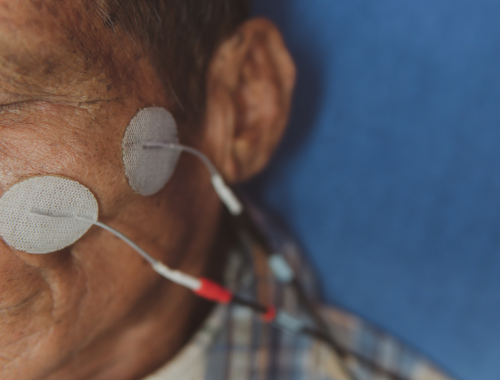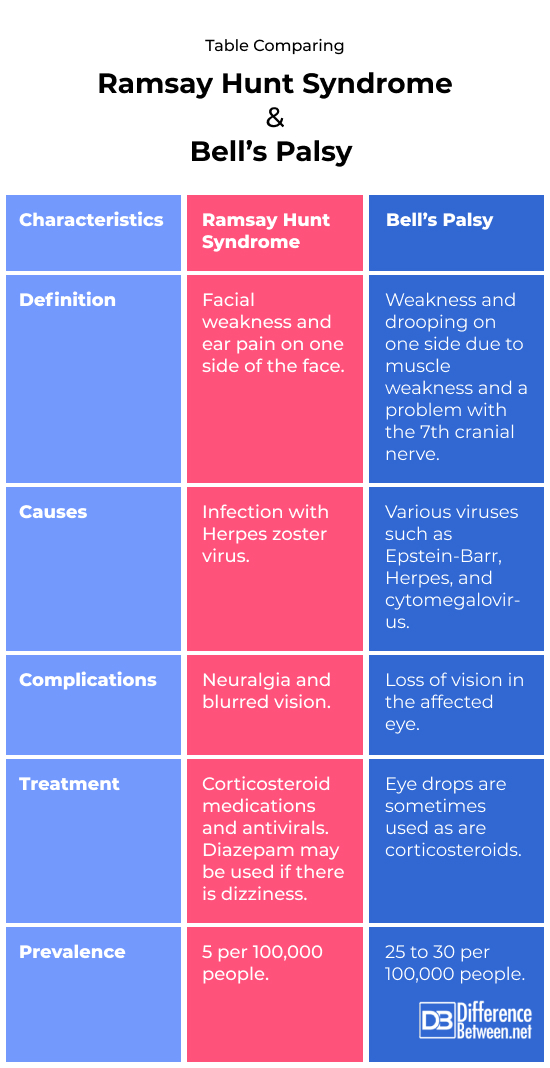Difference Between Ramsay Hunt Syndrome and Bell’s Palsy
Ramsay Hunt syndrome is when part of the face is affected due to the varicella-zoster virus. Bell’s palsy is when a cranial nerve of the face is inflamed.

What is Ramsay Hunt syndrome?
Definition:
Ramsay Hunt Syndrome is a condition as a result of a specific Herpes viral infection.
Causes:
Ramsay Hunt is caused by Herpes zoster (sometimes known as the varicella-zoster virus); this virus is the same virus that causes chickenpox and shingles.
Symptoms:
Symptoms of the Ramsay Hunt syndrome include pain in the ear and loss of hearing on one side of the face. A painful rash usually occurs around the affected ear. The patient may experience dizziness, be unable to close their eye and have paralysis on one side of the face.
Complications:
Complications can occur with Ramsay Hunt syndrome. The condition can result in deafness in the affected ear and also blurred vision and even nerve pain (neuralgia) in the face on the affected side.
Diagnosis:
Diagnosis is based on the following three signs: ear pain, vesicles close to the ear, and facial paralysis on the one side of the body, which is the same as the affected ear.
Treatment:
Treatment options include using analgesics for the pain and antivirals such as acyclovir, which can lessen the severity of the infection. Corticosteroids may be given to help decrease the inflammation that occurs.

What is Bell’s palsy?
Definition:
Bell’s palsy is when the one side of the face weakens and becomes paralyzed because of a problem with a cranial nerve.
Causes:
It is suspected that Bell’s palsy is due to a viral infection such as, for instance, the Epstein-Barr virus, Herpes, or cytomegalovirus.
Symptoms:
Bell’s palsy patients complain about a headache, hearing loss, sore ear and weakness and paralysis of one side of the face. The eye may also tear up and not be easy to open or close.
Complications:
The condition can cause permanent nerve damage in the face. The person may also end up with blindness in the eye on the side of the face that is affected.
Diagnosis:
Imaging tests are used to rule out other potential conditions that look similar to Bell’s palsy, such as, for instance, a stroke.
Treatment:
Prednisone, a corticosteroid, is used for a week to help with the inflammation. Antivirals and eye drops may also be used to treat patients.
Difference between Ramsay Hunt syndrome and Bell’s palsy?
Definition
Ramsay Hunt syndrome is when there is facial weakness and ear pain on one side of the face. Bell’s palsy is drooping and weakness on one side of the face because of a damaged cranial nerve.
Causes
Infection with Herpes zoster virus causes Ramsay Hunt syndrome. Infection with one of a couple of viruses leads to Bell’s palsy.
Complications
Blurred vision and nerve pain can occur with Ramsay Hunt syndrome. With Bell’s palsy there can also be blindness and permanent nerve pain and damage.
Treatment
Treatment of Ramsay Hunt can be with corticosteroid medicine and diazepam. Bell’s palsy can be treated using eye drops and corticosteroid medicine.
Prevalence
Ramsay Hunt affects 5 out of 100,000 people. Bell’s palsy affects 25 to 30 of every 100,000 people.
Table comparing Ramsay Hunt syndrome and Bell’s palsy

Summary of Ramsay Hunt syndrome Vs. Bell’s palsy
- Ramsay Hunt syndrome and Bell’s palsy may look similar and both are caused by viruses.
- Ramsay Hunt syndrome also causes sores near the ear.
- Bell’s palsy is more common a condition than is Ramsay Hunt.
FAQ
What can be mistaken for Bell’s palsy?
Ramsay Hunt syndrome and stroke can be mistaken for Bell’s palsy.
What is Bell’s palsy and Ramsay syndrome?
These are two conditions that cause half the face to droop. They are both caused by viruses.
What is the main cause of Bell’s palsy?
The main cause of Bell’s palsy is some type of viral infection.
What triggers Ramsay Hunt syndrome?
The varicella-zoster virus reactivates and this is what causes the syndrome.
Does Bell’s palsy go away?
It does often go away on its own after a couple of weeks, but can last up to 6 months.
Are Bell’s palsy and Ramsay Hunt related?
Both conditions are related in the sense that both are associated with and caused by a type of virus. However, Bell’s palsy is more often found to be linked with Herpes simplex and Ramsay Hunt with Herpes zoster.
Is Bell’s palsy a mini stroke?
Bell’s palsy is not a stroke but it has similar symptoms with facial drooping.
Can covid virus cause Bell’s palsy?
There have been some cases where infection with COVID has led to a person having Bell’s palsy.
What is the link between COVID vaccine and Bell’s palsy?
The COVID vaccine from certain manufacturers has shown an increased, although rare, risk of Bell’s palsy.
What viral infection causes Bell’s palsy?
Certain types of viral infections cause Bell’s palsy such as cytomegalovirus and herpes.
Should I see a neurologist for Bell’s palsy?
Yes, you should always seek treatment for the condition. Often a general physician will refer you to a neurologist who specializes in nervous system disorders.
- Difference Between Rumination and Regurgitation - June 13, 2024
- Difference Between Pyelectasis and Hydronephrosis - June 4, 2024
- Difference Between Cellulitis and Erysipelas - June 1, 2024
Search DifferenceBetween.net :
Leave a Response
References :
[0]Lustig Lawrence R. “Herpes Zoster Oticus (Geniculate Herpes; Ramsay Hunt Syndrome)”. Merckmanuals. Merck & Co., 2022, https://www.msdmanuals.com/professional/ear,-nose,-and-throat-disorders/inner-ear-disorders/herpes-zoster-oticus
[1]Lustig Lawrence R. “Herpes Zoster Oticus (Geniculate Herpes; Ramsay Hunt Syndrome)”. Merckmanuals. Merck & Co., 2022, https://www.msdmanuals.com/professional/ear,-nose,-and-throat-disorders/inner-ear-disorders/herpes-zoster-oticus
[2]Rubin, Michael. “Facial Nerve Palsy (Bells Palsy; Bell’s Palsy)”. Merckmanuals. Merck & Co., 2022, https://www.msdmanuals.com/professional/neurologic-disorders/neuro-ophthalmologic-and-cranial-nerve-disorders/facial-nerve-palsy
[3]Tiemstra, Jeffrey D., and Nandini Khatkhate. "Bell's palsy: diagnosis and management." American family physician 76.7 (2007): 997-1002.
